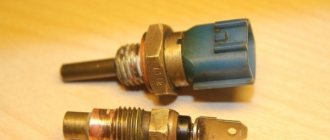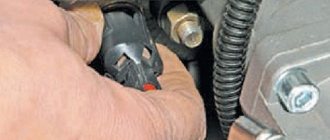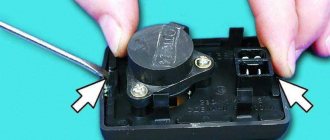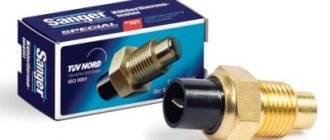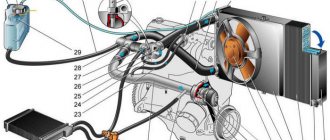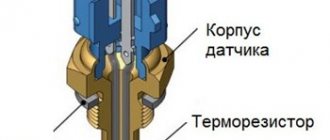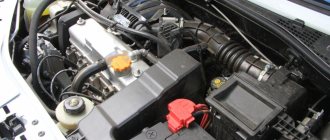The tenth family of the Tolyatti auto giant was equipped with injection engines. The first releases of cars were with 8-valve heads, and subsequent ones with 16-valve heads. Both engines were equipped with electronic control units (hereinafter referred to as ECU). The main controller collects readings from several sensors and adjusts the balanced operation of the engine (hereinafter referred to as the internal combustion engine). The temperature sensor on the VAZ 2110 is also responsible for interacting with the computer, and if it malfunctions, the “Check Engine” signal lights up, which in English means “Check the engine.” Next, we will tell you where the temperature sensor is located on the VAZ 2110, how to check and change it.
Attention! The injection "tens" have 2 coolant sensors. One for the arrow on the dashboard, and the second for exchanging data with the ECU and turning on the radiator fan. It's called DTOZH. The article is dedicated to him.
Temperature sensor VAZ 2110
The most important condition for the normal operation of a modern car is constant monitoring of the temperature conditions of its systems.
In Ladas of the tenth family, temperature sensors are used in the engine cooling system, air conditioning system, and also to measure the ambient air temperature outside the car.
The sensor is designed to control the heating of antifreeze that circulates in the car's cooling system. The measurement results are transmitted to the electronic control unit to automatically adjust the composition of the fuel mixture, adjust engine speed and activate the radiator cooling fan.
If the sensor is faulty, the injector does not work correctly, and when critical temperatures are reached, the fan does not turn on and the antifreeze boils.
The sensor is a resistor in a metal case, the electrical resistance of which varies depending on the temperature of the antifreeze.
For VAZ 2110 early releases, the temperature sensor was located in the upper part of the cylinder block, on the left side of the engine. The injection “Tens” are equipped with two temperature sensors:
- Coolant temperature sensor, the readings of which are read by the vehicle's ECU (this sensor is located on the front side of the thermostat housing);
- Antifreeze temperature gauge sensor on the dashboard (located in the engine block under the upper radiator pipe).
| Original | Analogs | approximate price | |
| ECU circuit temperature sensor | 2112-0385101005 | LUZAR: LS 0112 FENOX: TSN 22112 O7 | 100 – 350 rub. |
| Instrument panel temperature sensor | 2101-3808600 | LUZAR: LS 0101 FENOX: TSN 22101 O7 KRAFT: KT 104803 | 100 – 200 rub. |
The indicated sensors are the same for VAZ 2110 with 8-valve and 16-valve engines.
Tip: When purchasing a temperature sensor, make sure that the kit includes a metal sealing ring.
Operating principle of DTOZH
The VAZ-2110 temperature sensor works as follows. The thermistor located inside the sensor is an electronic device with a negative indicator of heating modes. The mode of temperature values up to 130 degrees reduces the resistance within 70 Ohms, and the lower limits at -40° increase the resistance to 107 kOhms.
The detector supplies +5 V to the temperature sensor through a constant resistor located inside it. The element determines the heating level of the antifreeze thanks to the potential difference across a thermistor with variable resistance.
Replacing coolant temperature sensors
Replacing a faulty temperature sensor is carried out as follows:
- The car is installed on a flat surface, the terminal is removed from the battery.
- The coolant is partially drained so that the antifreeze level in the engine block is below the sensor installation location.
- For free access to the place where the sensor is located, it is recommended to dismantle the air filter housing.
- The electrical wiring block is disconnected from the temperature sensor, and the sensor is turned out of the mounting hole using a spanner wrench “19”.
- A sealing washer is installed on the new temperature sensor; for additional sealing, the last couple of thread turns can be treated with a high-temperature sealant (for example, red “Abro”).
- Then the sensor is screwed into the hole, the connector is connected, the air filter housing is installed in place, and refrigerant is added to the cooling system.
After completing assembly, you need to start the engine and warm up the car until the fan turns on to make sure the system is working. You should also check the tightness of the installation of the new sensor visually.
The instrument panel indicator temperature sensor changes in the same way.
Operating temperature and causes of engine overheating
Under normal conditions, coolant circulation ensures a temperature of 86-90 °C. During hot periods, the indicator may lag, then after turning on the fan, the temperature stops at 94-108 °C. A frequent question from car enthusiasts: what is the temperature in winter when it’s cold? The first 10-15 kilometers the indicator may be below 80 °C, but after this point it should rise to 85-90 °C. These data are suitable for VAZ 2110 injector.
Also, the operating temperature depends on the type of firmware, fan speed and other features, so the normal value is 90-105 °C.
Now you know what the normal operating temperature of the VAZ 2110 is, so it’s time to study the reasons for its excess. If the “culprit” of the overestimated indicator is not the DTOZH, then the following actions should be taken:
- Check the outer part of the radiator for contamination.
- Replace the thermostat in the VAZ 2110 injector.
- Check the coolant level in the expansion tank; if it becomes low, add it to the required level.
- Adjust the ignition timing.
- Check that the fan is turned on.
Cabin temperature sensor
To control the heating system of the VAZ 2110, a cabin temperature sensor - DTVS is used. Based on its readings, the controller adjusts the position of the heater valve and the fan rotation speed, supplying cold or hot air to the machine. The sensor is located in the middle of the ceiling panel, behind the central lamp. The sensor consists of a thermoelement and a microfan installed in a rectangular plastic housing.
Replacing the temperature sensor with your own hands is quite simple: you need to carefully pry off the retaining latches with a screwdriver, lower the sensor and disconnect the wire block. The new device is installed in the reverse order. Catalog number of the original part: 2110-8128050-02, its average cost is about 800 rubles.
If, after installing a new sensor, inconsistencies arise between the mode selected on the climate control unit and the actual temperature in the cabin, then adjustments should be made. To do this, you need to remove the heater control unit from the panel and turn the adjusting screw on the left side of the case (to increase the temperature - clockwise, to decrease - in the opposite direction).
Sensor location on the engine
In order to check the coolant temperature sensor, you need to know where it is located. Naturally, this information will vary for cars of different brands and models. However, there are several typical signs by which you can find the place where the sensor is directly attached. So, in most cases it is located on the exhaust pipe of the cylinder head. Structurally, it has a metal thread, with which it is screwed into the corresponding hole. The main requirement in this case is to ensure direct contact between its sensitive element and the coolant. It is this contact that ensures the accuracy of the sensor readings.
Please note that some vehicles may be designed to have two temperature sensors installed. In this case, the first of them records the temperature of the coolant at the outlet of the engine (cylinders), and the second - at the outlet of the radiator. This approach makes it possible to more accurately monitor the condition of both the engine as a whole and its cooling system in particular. However, two sensors are usually installed on powerful and/or expensive cars, where this parameter is critically important, and the ECU contains special programs for engine operation. You can find additional information about the design of a particular car in the corresponding manual or technical documentation.
Outdoor temperature sensor
On “Dozens” of later releases with a VDO dashboard with two displays and a trip computer, an outside air temperature sensor was installed. When the engine was turned on, the temperature readings outside the VAZ 2110 were displayed on the instrument panel screen.
The sensor is located inside the front bumper, next to the front fog lamp. The installation side of the device in each specific case may be different (on the driver’s side or on the passenger side). If the temperature sensor was installed by the owner himself, then most often it was taped with electrical tape to the base of the towing eye.
Catalog number of the original temperature sensor: 2115-3828210-03, its approximate price is about 250 rubles.
If the outside air temperature sensor does not work, remove the plastic protection of the left or right front wheel arch (depending on the location of the sensor), disconnect the wiring connector and remove the sensor from the holder in the front bumper. Installing a new part is performed in the reverse order.
Source
When is replacement required?
Checking with your own hands and replacing the temperature sensor on a VAZ 2112 with an injection 16-valve engine is not difficult. Repair of this part is not advisable. If problems arise, you must purchase a new part. A faulty temperature sensor can cause serious problems.
First of all, the engine overheats. If incorrect data is sent to the ECU, the cooling fan will not turn on on time. Consequently:
- antifreeze will boil away;
- the radiator or other components of the cooling system may burst;
- the engine will overheat.
It is worth noting: overheating of the engine makes it impossible to continue normal operation. Major renovation will be required.
Therefore, it is advisable to replace it at the first sign of a malfunction of the temperature sensor. Main symptoms of failure:
- The radiator does not turn on - it starts only at the “command” of the temperature sensor;
- problems when starting the engine - this is especially acute during the first cold weather;
- when the engine is not warmed up - poor exhaust;
- the appearance of steam from the engine - this indicates overheating of the unit;
- Fuel consumption has increased significantly when outside temperatures are above zero.
The price of a temperature sensor is no more than a few hundred rubles. Therefore, it is advisable to purchase a spare one in advance. This will avoid problems associated with finding the part. If you suspect that the sensor is not working, you should replace it immediately. The part is not repairable.C
Temperature sensor for VAZ 2110
The tenth family of the Tolyatti auto giant was equipped with injection engines. The first releases of cars were with 8-valve heads, and subsequent ones with 16-valve heads. Both engines were equipped with electronic control units (hereinafter referred to as ECU). The main controller collects readings from several sensors and adjusts the balanced operation of the engine (hereinafter referred to as the internal combustion engine). The temperature sensor on the VAZ 2110 is also responsible for interacting with the computer, and if it malfunctions, the “Check Engine” signal lights up, which in English means “Check the engine.” Next, we will tell you where the temperature sensor is located on the VAZ 2110, how to check and change it.
Attention! The injection "tens" have 2 coolant sensors. One for the arrow on the dashboard, and the second for exchanging data with the ECU and turning on the radiator fan. It's called DTOZH. The article is dedicated to him.
Crankshaft regulator
As you understand, the location of all sensors on the 8-valve injection VAZ 2110 is different, but they are all combined into a single system. The crankshaft sensor is no exception.
Regulator
Through the operation of this device, the system determines when to supply fuel and a spark to ignite the mixture. In fact, the design of the unit is presented in the form of a magnet and a coil of thin wire.
Its strengths include:
- Works for a long time and efficiently even under high loads;
- Functions in conjunction with the crankshaft pulley;
- If the sensor breaks down, the engine stops working or limits the speed to no more than 3500 revolutions.
The device is located on the oil pump, literally at the very top of the pulley teeth. To be more precise, 1 millimeter from them.
Principle of operation
The mechanism of action of the temperature sensor on the VAZ 2110–2112 family is based on changing resistance parameters depending on the ambient temperature t°C. In essence, we have before us an electronic resistor with a negative temperature coefficient. That is, the lower the t°C, the higher the resistance of the device, and vice versa.
Table 1. Operating temperatures and parameters of DTOZH
| Temperature, t°C | Resistance, Ohm |
| 100 | 177 |
| 40 | 1459 |
| 25 | 2796 |
| 9420 | |
| −20 | 28680 |
| −40 | 100700 |
The presented values can be used to check the sensor with a tester. More on this below.
What function does DTOZH perform in the ECU system?
There is no damper (choke) on injection machines. Now the fuel is enriched or leaned by the control unit using the t°C values coming from the DTOZH. In addition, the main controller monitors the operating temperature of the engine and gives a command to turn on the fan if it overheats.
Speed sensor
It provides the electronic system with data about the current speed of the vehicle. It is relatively reliable, but in reality, developers have a lot to think about.
Location
It has two characteristic malfunctions:
- At idle speed the engine turns off;
- A broken sensor can partially affect the speed characteristics of the car.
Causes and symptoms of malfunction
Service workshop technicians say that in 90% of cases, the breakdown of the temperature sensor on a VAZ and other brands of cars occurs due to natural causes. Most often, a break in the internal contacts of the resistor occurs. As a result, the DTOZh sends incorrect parameters to the ECU, for example, engine starting t° within 0 °C. The control unit considers the engine cold and gives a command to another sensor - the mass air flow sensor - to reduce the air supply, that is, to enrich the mixture. Therefore, a warmed-up engine begins to work strangely, “excitedly” with failures. Here are 3 more most common reasons for the incorrect operation of the DTOZH:
- The seal of the sensor housing is broken.
- There was a break in the electrical wires.
- The power supply has fallen off.
In the above cases, the ECU does not see the DTS system, so it attracts the driver’s attention with a “Check Engine” signal on the dashboard. In this case, the operation of the car becomes unusual:
- the engine starts with difficulty and tends to stall;
- the speed fluctuates even on a warm engine;
- strong detonation is felt;
- the former power is lost.
In addition, fuel consumption increases, and dark smoke comes out of the exhaust pipe. It is necessary to make a diagnosis. To do this, you can go to a car service center, or install a special application on your smartphone and buy a Bluetooth adapter.
Mass air flow sensor (MAF)
It is one of the most important sensors. The mass air flow sensor is responsible for the formation of the air-fuel mixture. It measures the volume of air supplied to the intake receiver and transmits the readings to the electronic engine control unit, which in turn supplies the right amount of fuel in relation to air. The failure of this sensor affects many different functions of the internal combustion engine.
It should be noted that the “CheckEngine” lamp will light up only if the sensor fails completely. Most often, the sensor undergoes aging, but very rarely fails completely. You can read how to check this sensor in our article.
Signs of malfunction:
- Increased fuel consumption;
- Uneven idle speed;
- Difficulty starting the internal combustion engine;
- Loss of dynamics;
- Jerks when moving;
Where is DTOZH located?
All front-wheel drive VAZ cars received a transverse internal combustion engine. If you look down, between the cylinder head and the air filter housing, you can see the location of the DTOZH. It is built into the coolant flange pipe and looks in the direction of travel, that is, towards the radiator. A block with two wires fits into it. (A little lower, directly in the block, there is another coolant temperature sensor. Thanks to it, we can see the t°C level on the dashboard. 1 white-green wire goes to the device).
Coolant temperature indicator
Coolant, as you already know, is a coolant. It also has its own special sensor. In its functions, it resembles a choke, which is installed on carburetor versions of the VAZ 2110 and others.
Device that reads coolant temperature
That is, this sensor is responsible for regulating the fuel. The colder the engine is, the more fuel it will receive. This indicator is characterized by certain breakdowns:
- Electrical contact inside the regulator may be broken;
- Near the accelerator cable there are wires that often lose their insulation;
- The sensor fails if the fan starts to operate when the power unit is cold;
- Certain difficulties arise when starting a very hot engine;
- If the sensor breaks down, increased fuel consumption occurs.
Which sensor to choose
Independent automotive industry experts and service workshop specialists are of the opinion that it is better to buy original spare parts or branded analogues. The latter are selected according to codes in special combination programs. The coolant temperature sensor, VAZ 2110–2112 family, has serial number 21120–3851010–00. Sometimes at the end, instead of 00, you can see: 01, 02, 03. This indicates that the device was made at one of the related AvtoVAZ enterprises.
Table 2. Price of the original DTOZH and its foreign analogues
| Manufacturer | Number | Amount, rub. |
| GM AvtoVAZ | 21120–3851010–00 | 250 |
| AvtoVAZ | 21120–3851010–82 | 165 |
| Magneti marelli | 1719 16011 150 | 355 |
| Hella | 6PT 009 107–271 | 735 |
| Eps | 1.830.098 | 1080 |
Sources: autopiter.ru, exist.ru.
Interesting fact. Some owners buy exclusively foreign spare parts for their “tens”. The same shock absorbers, struts, springs, timing belts, electrical equipment and other parts “from there” last much longer.
Checking operation and replacing the sensor
Checking the sensor for serviceability when diagnosing problems with a car comes down to measuring its voltage when it is at rest. Measurements are taken with the engine not yet running. You can take readings using a regular multimeter. You need to pierce the wires near the connectors of the sensor being tested as carefully as possible and record the voltage between pins 3 and 5.
For a working sensor, the readings will be 0.996 V, and if it is faulty or its readings are incorrect, then the voltage value will be more than 1.7 V. With such readings, it is better to replace the mass air flow sensor as soon as possible. To replace it on a VAZ 2110 car, you do not need special knowledge or skills.
The replacement procedure is a set of simple steps that even novice car enthusiasts can easily handle. You need to remove the negative cable from the battery, then drain the radiator. Next, you can proceed to dismantling the air filter.
It must be removed to make it more comfortable to replace the sensor. Then you need to squeeze out the plastic clip that holds the wire block from the sensor. Now all that remains is to dismantle the sensor itself, and then install a new one in its place and carry out all the steps in the reverse order.
It is advisable to purchase a coolant and mass air flow sensor of those models that are recommended by the manufacturer for the VAZ 2110. Their price is low, and a lot depends on the quality of these devices. It is necessary to carefully monitor the serviceability of the sensors and the veracity of their readings. Then it will be possible to avoid engine overheating and other problems with the “ten”.
1200 rub. for the photo report
We pay for photo reports on car repairs. Earnings from 10,000 rubles/month.
Write:
Checking the temperature sensor is a simple procedure that even a novice car enthusiast can handle. The coolant temperature sensor (abbreviated as DTOZH) is a thermistor, that is, a resistor that changes the value of its internal resistance in accordance with the temperature where its actuator is placed. Most often, a multimeter is used for this (another name is a tester, “tseshka”), which is able to measure the value of electrical resistance in a circuit.
How to check
There are many cases in history when the owner installs a new spare part, but it does not work. Therefore, after purchasing a temperature sensor, it is recommended to measure the resistance before installing it on the same VAZ or another car. To do this you will need a multimeter (tester). We convert it to an ohmmeter. At room temperature (+23 °C, +25 °C), the readings should be around 2780 Ohms (as in table No. 1). If you lower the DTOZH into a glass of boiling water (+100 °C), hold it for a while and take readings, a result in the range of 175–180 Ohms should appear on the tester screen. This means the purchase is in good condition. Can be installed on a car.
Replacement
Before repairs, it is necessary to carry out a number of preparatory measures. First, you should choose a level area for the machine. It can be in the garage, it can be outdoors. Secondly, prepare the tool: open-end and ring wrenches (19 mm, 13 mm, 10 mm, 8 mm). You will also need a capacious medical syringe of 100–250 ml, a 15–20 cm dropper tube and a 0.5–1 liter jar (so as not to drain the antifreeze/antifreeze). The sequence of actions is as follows:
- We wait until the engine cools down completely.
- Use a syringe to pump out the coolant from the expansion tank (100–200 ml).
- Unscrew the negative terminal of the battery (10–13 mm wrench).
- Unscrew the air filter housing fasteners (8 mm wrench).
- Carefully tilt the “pan” to the right.
- Disconnect the power supply from the DTOZH.
- We unscrew the sensor (19 mm wrench).
- We clean the landing area from dirt.
- We screw in the new DTOZH.
The assembly must be done in reverse chronology. There is no need to use sealant, since the copper O-ring fits perfectly and seals the connection. Let's start the engine. We check its operation and inspect the repair area for antifreeze leaks. The entire event takes 15–20 minutes.
Where to buy car accessories
Spare parts and other products for the car are easily available for purchase at auto stores in your city. But there is another option that has recently received significant improvements. You no longer need to wait a long time for a parcel from China: the AliExpress online store now offers the opportunity to ship from transshipment warehouses located in various countries. For example, when ordering, you can specify the “Delivery from the Russian Federation” option.
Follow the links and choose:

